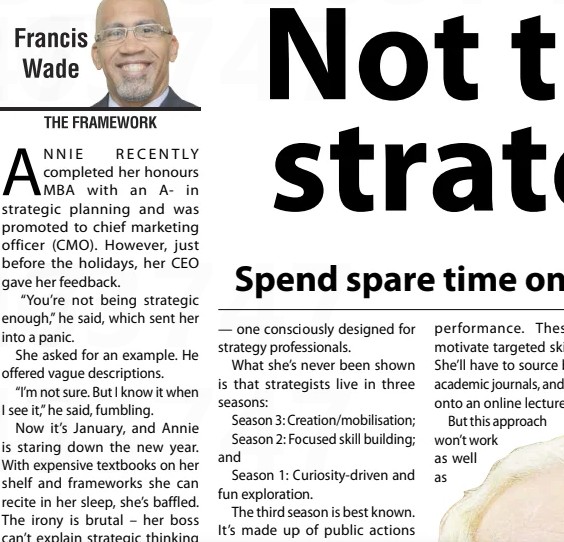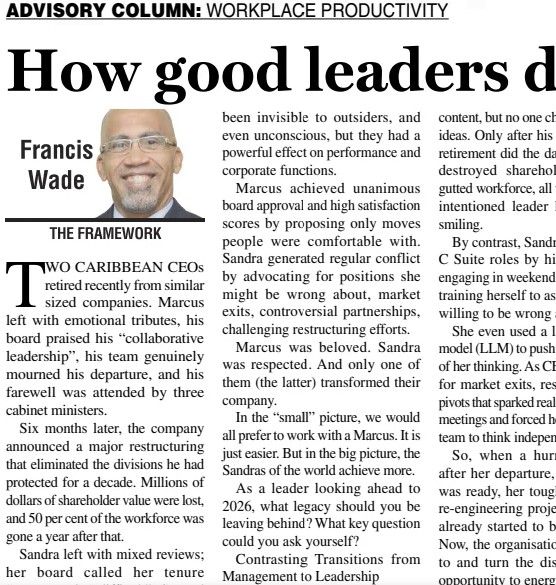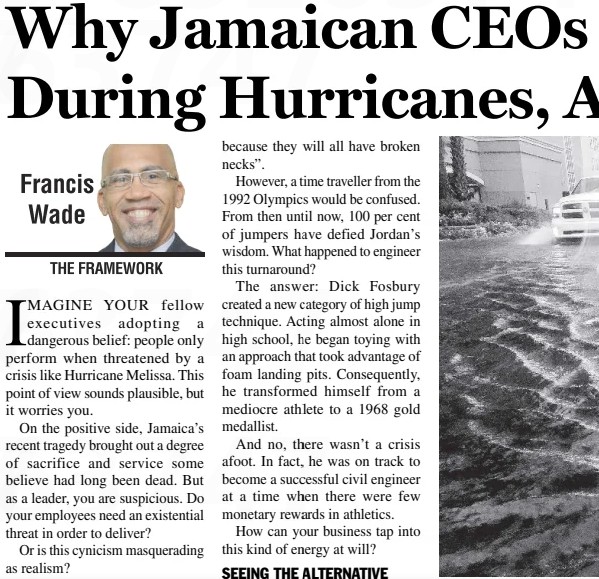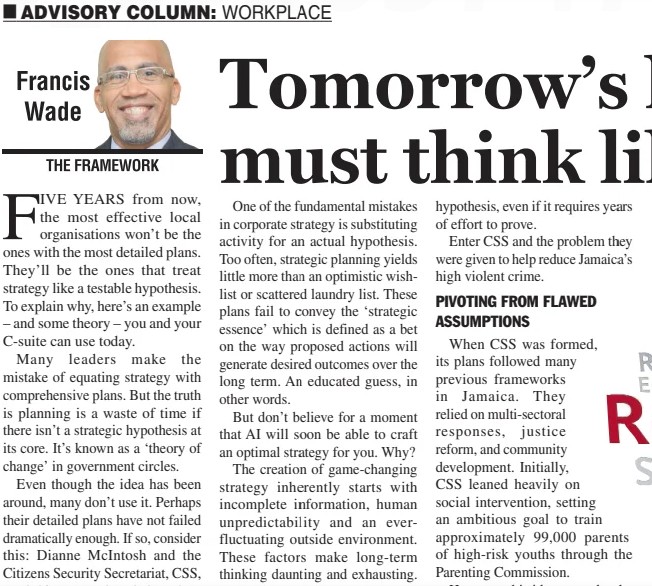Annie’s hands trembled as she reread the email from her CEO. “Let’s talk about developing your strategic capabilities.”
She’d just earned her MBA with honors, landed a promotion to Chief Marketing Officer, and crushed her Strategic Planning course with an A-. Now, three weeks before Christmas, her boss wanted to discuss her lack of strategic thinking.
The meeting went poorly.
“You’re just not being strategic enough,” he said, arms crossed.
“Can you give me specific examples?” Annie asked, pulling out her notebook.
He waved his hand vaguely. “It’s hard to explain. I just know it when I see it.”
She pressed for details. He offered hollow phrases about “seeing the big picture” and “thinking long-term.” Nothing concrete. Nothing actionable. By the time she left his office, both were frustrated.
Now it’s January. Annie sits at her desk, surrounded by expensive textbooks and highlighted case studies, completely lost. She can recite Porter’s Five Forces backward. She built financial models that made her professors weep with joy. Yet somehow, she’s failing at the very thing her degree promised to teach.
The brutal irony? Her CEO can’t articulate what strategic thinking actually is because he developed the skill unconsciously, through years of pattern recognition. Annie can’t demonstrate it because her MBA systematically removed the very experiences that build strategic intuition.
They’re both trapped. And neither understands why.
The MBA’s Fatal Flaw
Annie isn’t alone in this predicament. Across boardrooms worldwide, formally trained managers struggle to translate their academic frameworks into real strategic insight. They possess intellectual tools but lack the deeper capability that separates strategic thinkers from strategic memorizers.
Here’s what business schools won’t tell you: becoming genuinely strategic isn’t about learning more frameworks. It’s about understanding that strategy professionals operate in three distinct seasons—and most never experience the first two.
Season 3: Creation and Mobilization
This is the visible season. Senior leaders gather to craft corporate strategy over one to three months. PowerPoint decks multiply. The C-Suite debates market positioning. Consultants bill impressive hours. This is what most people imagine when they picture “strategic work.”
Season 2: Focused Skill Building
Between major strategic initiatives, professionals identify capability gaps and target specific learning. They read journals, attend workshops, and study new frameworks. MBA programs excel at teaching a few basic Season 2 skills.
Season 1: Curiosity-Driven Exploration
This is the secret season. The forgotten season. The season where strategic intuition actually develops.
And it’s completely absent from formal business education.
Warren Buffett’s Secret Curriculum
To understand why Season 1 matters so profoundly, consider how Warren Buffett transformed Katherine Graham from overwhelmed newspaper heiress into one of America’s most respected CEOs.
In 1963, 46-year old Graham suddenly inherited control of The Washington Post after her husband’s death. She’d been a housewife with zero business experience. Now she faced a company, competitors, and boardroom dynamics she didn’t understand. Terrified but determined, she reached out to Buffett for guidance.
What happened next reveals everything about how strategic thinking actually develops.
Buffett didn’t send her to business school. He didn’t recommend management textbooks. He didn’t even explain financial statements, despite being one of the world’s greatest investors.
Instead, according to researcher Cedric Chin, Buffett quietly assembled a curated collection of annual reports from diverse companies across multiple industries. Then he sat with Graham and walked her through them, one by one.
But here’s the crucial detail: they didn’t analyze balance sheets or scrutinize financial ratios. They discussed stories. Why did this CEO make that decision? What pattern do you notice across these three retail failures? How did this manufacturer navigate technological disruption?
Over months of discussing hundreds of these narratives, Graham developed something more valuable than financial expertise. She built a mental library of business patterns—a sixth sense for recognizing strategic situations before they fully materialized.
The result? A powerful 28-year tenure that transformed The Washington Post into a media powerhouse.
Any MBA professor would dismiss Buffett’s approach as unscientific, inefficient, and impossible to grade. Yet it produced extraordinary results. Why?
The Ill-Structured Domain Problem
Corporate strategy isn’t like chess. Chess has clearly defined rules, limited possible moves, and objective evaluation of positions. Master chess by studying enough positions and you’ll reliably improve.
Strategy operates differently. It’s what cognitive scientists call an “ill-structured domain”—a field where:
- The rules constantly change
- Problems arrive with incomplete information
- Multiple valid solutions often exist
- Varying contexts determine which frameworks apply
- Pattern recognition trumps analytical rigor
In ill-structured domains, you don’t become expert by memorizing frameworks. You develop expertise through massive exposure to varied cases, gradually building intuition about what patterns matter and which don’t.
This is why Annie’s MBA, for all its rigor, failed her. Business schools teach Season 2 skills in Season 2 format: structured, analytical, framework-driven. But strategic intuition develops in Season 1, through unstructured, curiosity-driven exploration of countless business stories.
Her professors taught her to dissect strategies. Buffett’s method taught Graham to recognize them in the wild.
Annie’s Accidental Discovery
Over the Christmas holidays, Annie found herself doing something she normally avoided: falling down a YouTube rabbit hole.
It started innocently. She’d always wondered why Apple’s iPhone crushed Blackberry, Nokia, and Ericsson—giants that seemed untouchable until they weren’t. A Google search led her to a documentary video. That led to another. And another.
Four hours later, having watched 21 videos spanning mobile phone history, product launches, and CEO interviews, she emerged with a strange new capability. She could now answer a question she’d never consciously considered: “What would I have done differently as CMO at Nokia?”
But immediately, guilt set in. Had she just wasted an evening on the digital equivalent of binge-watching reality TV or TikTok? Shouldn’t she be reading the Harvard Business Review journal articles sitting in her queue?
What Annie didn’t realize: she’d accidentally stumbled into Season 1 learning.
That “wasted” evening accomplished something her expensive Strategic Planning course never could. By immersing herself in multiple failure narratives, she began building the pattern recognition library that expert strategists draw from automatically.
One case study teaches frameworks. Twenty-one interconnected stories start building intuition.
Building Your Own Season 1 Practice
The transformation Annie needs won’t come from reading one more business book or taking another certification course. She needs to deliberately create her Season 1 practice.
Here’s what that looks like:
Consume voraciously, but with purpose.
Watch YouTube documentaries about business failures. Read long-form narratives about company transformations. Follow industry evolution stories across decades. The key isn’t passive consumption—it’s exposing yourself to enough varied cases that patterns start emerging naturally.
Ask the practitioner’s question.
Don’t just absorb stories. Constantly ask: “What would I have done as CMO/CEO/strategist/consultant in this situation?” This active engagement transforms entertainment into training.
Seek variety over depth initially.
Early in Season 1, breadth matters more than depth. Sample retail failures, tech disruptions, manufacturing transformations, and service industry evolution. Cross-industry patterns are often more valuable than industry-specific expertise.
Let curiosity lead.
Unlike Season 2’s targeted learning, Season 1 works best when you follow genuine interest. That four-hour YouTube session worked for Annie because she authentically wanted to understand mobile phone competition.
Connect consumption to creation.
Eventually, Season 1 exposure fuels Season 2 learning, which prepares you for Season 3 execution. But the sequence matters. Don’t rush to application before you’ve built sufficient pattern recognition.
The Real Competitive Advantage
When Annie returns to her next major strategic initiative—her next Season 3 moment—she’ll show up differently. Not because she learned new frameworks, but because she’s developed strategic peripheral vision.
She’ll recognize patterns her CEO can’t articulate but knows when he sees. She’ll spot familiar dynamics in unfamiliar situations. She’ll propose approaches that feel intuitively right, even if she can’t immediately explain why.
This is what her boss meant by “strategic thinking.” Not framework mastery. Pattern fluency.
And her company becomes the ultimate beneficiary. Now they have a CMO who brings genuine strategic intuition to every discussion—the kind of thinking that can’t be faked, purchased, or crammed before a meeting.
It just has to be grown, season by season, story by story.
———————————
P.S. You are invited to share in my compilation of strategy-related YouTube videos at StratCinema.org
P.P.S. This article is based on a column I wrote for the Jamaica Gleaner.
P.P.P.S. Here are some LLM prompts you can use for further learning.
Here are instructions and 5 prompts for readers developing strategic fluency:
Before Using These Prompts
Copy and paste this context into your LLM to get better responses:
“I’m developing strategic intuition by studying business cases, company failures, and industry transformations—an approach called Season 1 learning. Unlike traditional MBA education that focuses on frameworks, I’m building pattern recognition by exposing myself to many varied business stories. I’ll be sharing cases I’ve consumed (YouTube videos, articles, books, documentaries) and asking you to help me extract strategic insights and patterns. Your role is to help me think like a practitioner who must make decisions under uncertainty, not like an academic analyzing what already happened. Push me to identify what I would have done differently and what patterns I’m noticing across multiple cases.”
Prompt 1: The Practitioner’s Debrief
“I just watched/read [title/description of case]. Here’s what happened: [2-3 sentence summary].
Now help me process this as a strategist-in-training:
- What was the critical decision point where things could have gone differently?
- If I were [specific role: CMO/CEO/Head of Product] at that moment, what information would I have lacked that seems obvious in hindsight?
- What would I have needed to believe or notice to make a better choice?
- What’s one pattern here that might appear in completely different industries?”
Prompt 2: Cross-Case Pattern Recognition
“I’ve now consumed [number] cases about [general theme: tech disruption/retail transformation/product failures/etc.]. Here are brief descriptions of 3-5 of them: [list cases with 1-sentence descriptions].
Help me identify:
- What strategic pattern appears in at least 3 of these cases?
- What does this pattern look like in its early stages, before the outcome is obvious?
- When this pattern appears, what are the hard-to-see warning signs?
- What would ‘seeing this pattern early’ have enabled in each case?
- In what completely different context might I encounter this same pattern?”
Prompt 3: The Mental Library Builder
“I want to add this case to my ‘mental library’ of strategic patterns: [describe case].
Help me catalog it effectively:
- What’s the one-sentence ‘pattern name’ I should remember this case by?
- What are the 2-3 specific details that make this pattern recognizable in real-time?
- Which other cases in my library does this connect to or contradict?
- If I’m in a strategy meeting and this pattern is emerging, what question should I ask to test if it’s really present?
- What’s the ‘inverse’ of this pattern—what does success look like when someone navigates this well?”
Prompt 4: The Scenario Transfer
“I just studied how [Company X] failed at [situation]. Now help me practice transferring this insight:
Imagine I’m [specific role] at a company in a completely different industry—say [name specific industry]—and I’m seeing these three signals: [describe 3 current business signals].
- Could the pattern from [Company X]’s failure be emerging here?
- What would I need to investigate to confirm or rule out this pattern?
- If it IS the same pattern, what would I do in the next 30/90/180 days?
- What would cause me to be wrong about this pattern applying?
- What other patterns from my library might explain these signals better?”
Prompt 5: The Strategic Intuition Audit
“I’ve been doing Season 1 learning for [time period]. I’ve consumed approximately [number] cases covering [list topic areas].
Help me audit what strategic intuition I’m actually building:
- Based on what I’ve described, what are the 3-4 patterns I seem to be recognizing most readily?
- What types of strategic situations am I probably still blind to?
- Where are the gaps in my mental library? (What industries, failure modes, or strategic contexts am I under-exposed to?)
- Given my role as [your actual role], which 5 specific case types should I prioritize consuming next to build practical pattern recognition?
- How would I know if I’m moving from ‘consuming cases’ to ‘recognizing patterns in real-time’?”
How to Use These Prompts
Start with Prompt 1 after every case you consume. Use Prompt 2 weekly after you’ve accumulated several cases. Deploy Prompt 3 when a case feels particularly instructive. Use Prompt 4 monthly to practice transferring insights to your actual work context. Run Prompt 5 quarterly to ensure your Season 1 practice is building genuine strategic intuition, not just entertainment consumption.
Note – this article is based on a column written for the Jamaica Gleaner.







